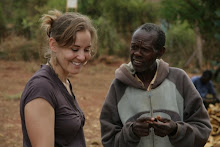Have you seen The Constant Gardener? Do you remember the rolling sprawl of rusted tin roofs in Kibera? Did the movie capture the fractured earth, the plastic bag-choked bits of green amidst the ever-present brown?
I went to Kibera for the first time shortly after I arrived here to visit Red Rose School. I wore the wrong shoes, and was cautioned that were I ever to go through the gate next to the school that beckoned into the depths of the slum I better make sure my feet were covered. I’ve been back many times since to the inner Toi market (fabulous used clothing market, I have a friend who got an authentic Louis Vuitton for under $1) and Makina market where my tailor is. All these visits allowed me to say, “yes, I’ve been to Kibera” though none of them in anyway conveyed the reality of the place I visited for the first time today. The border does not betray the inner sanctum’s reality. No, it does not.
My class had a field day today where we were tasked with visiting an acting development project. I arranged for us to visit school empowerment groups in Kibera that are being run as part of my house mate Megan’s organization, Zanna. I’ve been wanting to visit for ages and this was a great opportunity to do so. Plus, the vision and strategy behind Zanna is exactly what I think the development field needs in order to have a hope and a prayer of actually solving the problems that continue to permeate countries like Kenya.
The first thing you notice about Kibera is the abundance of children, all of whom seem to be the same size. It’s like a slum full of four year olds, all fluent in the language of “How are you!” of which as a mzungu I heard continuously throughout my visit. Then you realize how careful you’re being walking, and the sense of risk you feel as you attempt to peel your eyes from the uneven ground in order to take in the sites and smells around you. A butcher. A sausage cart toiling as it would over a cobbled street but leaving a trail of loose rock in its wake. Mamas and babies peeking out of low, dark windows. A woman in a purple lesso sifting and lightly blowing on maize with a rhythmic toss. Children everywhere, laughing and running, holding hands. A pair no more than three, each wearing one blue flip flop on the opposite foot. What friendship.
I admit I loved being there. I loved the children running by and giving me high fives. I love any opportunity to be reminded how people survive and make the most of the worst of conditions. To find an alternative to the individual stories of grief and despair, to the continued political and ethnic debauchery, the remaining IDPs, the rampant corruption. The sun was shining. Life continues.
One of our professors, a recent PhD graduate assisting our research-burdened tenured staff walked with me for a time. He couldn’t contain his disgust, his frustration at the scene. He takes it more personally than even I do for all my struggles with the inadequacies of humanity. How can some of us rock climb for fun while others build houses upon shifting land amidst rocks of poverty-laden rubble? He is Kenyan, these are his people. This is his land, right nearby the “poor” area he himself lives in. An area that cannot compare to the filth of Kibera.
Kibera, for all the attention it has received, is no joke. Incomes, where they exist, are cobbled together. I passed many tarps of odds and ends – rusted wrenches, dented mechanical parts I could not name, bits of old metal and wire for which I couldn’t imagine a purpose. Every once in awhile a shiny mobile phone. On one tarp, a single upside down porcelain urinal filled with buttons.
It is hard to reconcile my ability to see the beauty, joy and goings on of life in the slum, with the revolting site you have to process in order to know it must be changed. The land is sucked of the green. The water is scarce, the trash unbelievable. Children meander through filth, shining their glorious youth and innocence in order to make it human, to make it bearable.
There is music, constant music. There are babies being held, old men shooting the shit, hunched grandmas walking together. It is life, at the same time as it should, and never should, be.
Subscribe to:
Post Comments (Atom)


3 comments:
You've painted a stark and accurate picture. Beautiful, tragic writing
So will watching the film give me a reasonably accurate insight into the reality of Kibera? You almost suggest it won't. Anyway I am very keen to watch it now.
Megan
This post is a wonderful piece of writing and so very accurate. It describes the indescribable so well.
I visited Mathare in 2007 smaller than Kibera but identical.
May I have your permission to use your post for my Rotary work within RFFA or Rotarians For Fighting AIDS?
http://theork.com
Warmest Greetings
John Glassford.
Coolamon NSW Australia.
Post a Comment